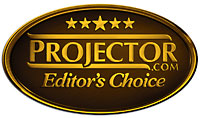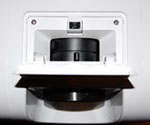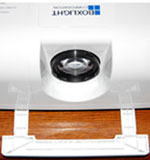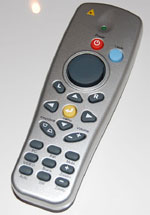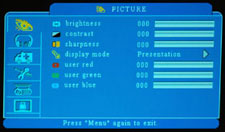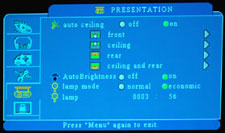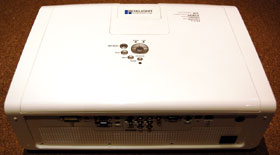 |
; |
Street Price: $2,699.99 (USD) When we think of multipurpose projectors that are ideal for small and large spaces (boasting a high ANSI lumen output), the notion of portability, and the idea of being lightweight and stylish very likely never enter into the equation. With the MP65e, Boxlight has done their best to accommodate everyone with a high-end, multipurpose projector whose portability is only superseded by its ability to perform equally as well in a boardroom as it would in an auditorium. FIRST IMPRESSIONS – Boxlight LCD ProjectorStyle & Appearance The Boxlight MP65e LCD projector features an attractive case design that manages to artfully combine the square look with modern, rounded edges, in an enticing pearl white color finish with light gray trim. The MP65e also lives up to its multipurpose tag by offering convenient portability by way of its lightweight build (16.5 lbs. / 7.5 kgs.) and its relatively unimposing dimensions (W x H x D: 14.2 x 5.7 x 18.9 inches / 36.1 x 14.5 x 48.0 cm). Looking at the projector head-on, the lens is placed dead center and features a focus ring as well as a zoom ring (1.2:1) which can be accessed by flipping open the small compartment just above the lens and on top of the LCD projector. In terms of lens protection, I like what Boxlight has done with the MP65e. It offers a fixed (of sorts), clear plastic lens cover by virtue of a string which connects from the lens cover to the projector. This is a great benefit that guarantees whenever you remove the lens from the projector, you never have to worry about losing it. Another great Boxlight touch with the MP65e: the actual lens itself is safely tucked an inch or so back from the front of the projector and doesn’t stick out – sometimes dangerously exposed – as you’ll see with some others brands of projectors. The top of the projector features the usual array of button control options such as Power, Menu, Input, and keystone control, along with light indicators for your lamp and power. In terms of replacing the lamp and air filter, the left-hand side of the MP65e projector offers quick and convenient access to the lamp, while the right-hand side replicates that easy convenience by offering access to the air filter. As an added bit of handiness, the bottom of the projector (directly under the lens) features a slide-out, hidden carrying handle that can be used when transporting the projector over short distances. Keyword here being short distances. For those longer, scrambling mad dashes across town, it’s recommended you find a more secure and stable means of transport. Let’s now get into the connectivity of the MP65e LCD projector. Getting Connected Like all good multipurpose projectors, the MP65e offers a nice, broad range of connection inputs that can be found at the rear. It features connectivity for Component, DVI-I, S-Video, Composite, and VGA. While an HDMI input is noticeable by its absence, it does offer great functionality via a LAN, network ready, RJ-45 interface that allows you to manage and monitor the projector using a wired / wireless network. Another point worth mentioning regarding the lack of an HDMI connection: the MP65e, while being a multipurpose, portable, LCD projector, is, in fact, more geared towards business and academic applications/presentations, and home theater usage, while still very doable and effective through a Component or DVI or S-Video connection, is not the main basis of being for the MP65e. PERFORMANCE – Boxlight LCD ProjectorSet-Up Okay, so you’ve taken the MP65e out of the box and now it’s time to set up your LCD projector. The very first thing to keep in mind: this is not a short-throw projector, and to be fair, nothing in its makeup, design, build, or primary functionality would lead you to believe otherwise. It features a zoom lens of 1.2:1, and if you’re planning on projecting an image in and around the 100-inch mark, plan on leaving a good 20 feet-plus worth of clearance between the projector and your screen. I initially attempted to project a 106-inch image from about 16 feet back, and the image bled over about 6 inches both vertically and horizontally. Assuming you have the requisite distance between projector and screen, the MP65e also offers a keystone adjustment of plus or minus 30 degrees if you should need to make further adjustments to your projected image. Before delving into the image quality of the Boxlight MP65e, there are a couple of things worth covering in advance. The first thing is versatility. The MP65e has this in spades. In addition to being able to manage and control your projector over a wired/wireless network via a RJ-45 interface, the MP65e LCD projector has an ANSI lumen output range of 3800 (Eco) to 4500 (Normal). This means that whatever the circumstance you’re dealing with: small room with dim light or bright light, or a very large room with dim light or bright light – or essentially anything in between – the MP65e has the output power to handle it all, without ever having to skip a beat. Additionally, this projector features an Auto Brightness feature which, if enabled, automatically detects ambient light and adjusts accordingly, thereby saving and extending precious lamp life. The second thing is security. The MP65e features an internal auto sensor that does two important things: (1) it manages airflow more efficiently, assuring your projector is always in peak operational form, and (2) it automatically alerts and reminds you when your air filter needs to be changed. The very last thing you want or need during crunch time is hardware issues, and this helps alleviate that. Another feature which falls under the banner of security is a PIN, password security feature that the MP65e LCD projector offers on start up. While on the surface this may sound like a great feature – no meddling or itchy fingers tampering with your projector and its settings – it has the very definite possibility of being both a positive and a negative. Quite simply, if those meddling and itchy fingers belong to someone who also wants to add cruelty or tasteless humor to their repertoire, they can purposely time out the projector’s three password prompts. Further, if you happen to forget or misplace your password and fail on your three password prompts, the projector completely shuts down and ceases to function. If all of this happens on the heels of that big or important presentation, you’re now faced with having to call Boxlight or your vendor Out-Of-Box Picture For image testing purposes, I connected (via a DVI to HDMI cable) the MP65e projector to a Sony PS3 for high-def, Blu-ray playback, featuring the infinitely stellar Planet Earth from BBC, with 1080i and 1080p output. Between both 1080 outputs, there were no discernible differences in image quality. As always, I first tested the projector using only out-of-box, factory default settings. One thing you notice right away is just how bright the image is. By default, the Lamp Mode is set to Normal which utilizes up to 4500 advertised ANSI lumens. In a dark to moderately lit room of average size, this is an overwhelming amount of light output that you’ll likely never really need, but as they say, better to have and not need, than to need and not have. Incidentally, for the amount of brightness, the image’s colors were a little washed out and muted in certain segments. I say a little and slightly because it was just that, and for all intents and purposes, it didn’t really detract very much from the quality of the actual image. Flipside, for an image that was just out of the box and free of any adjustments, the contrast was above average, and colors became a bit more lively and detailed during the brighter, day scenes, with particularly strong whites on display. The blacks were good, and though not particularly astounding, they more then did the job. All in all, for a projector not designed for home theater purposes, it does an above average job out of the box when called upon for video playback.
As with all out-of-box projectors, it was now time to make some image adjustments by eye. Before heading to the Picture menu, I visited the Presentation menu first. I set the Auto Brightness to “on” and changed the Lamp Mode from “normal” to “economic.” These two moves alone improved the brightness levels, garnering a more cinematic, warmer image. I then moved on to the Picture menu. Worth noting: the MP65e features seven different display mode options that include Natural (default), Cinema, User, Green Board, Powerful, Video, and Presentation. While some have very specific uses: Cinema (ideal for movies) and Presentation (computer usage), others such as Natural or Powerful can be subjectively used depending on your preference. While Cinema worked best with my image, I opted to set my Picture Display to User and used the following other settings below:
Please note: as per the DVI to HDMI cable connection that I used, the two additional picture display options of Color and Tint were not available for adjustment. You’re only able to have to access to those when using a Component, S-Video, or other such video connection. Generally speaking, you seldom have to adjust the Tint, while the Color usually needs to be increased to enhance the saturation levels of your image’s colors. As for the adjustments made by eye, I was now starting to see some satisfying and pleasing eye candy: contrast continued to get better, going from above average to very good, the overall image and color quality was punchier, and the projector did a particularly great job at seamlessly rendering brightly blown out scenes that featured lens flare and sunshine rays. With a projector like the MP65e that’s also (more so) geared towards PC-based applications and presentations, I also hooked up the projector to my laptop via the RGB cable that Boxlight generously includes with this projector. Projecting from a variety of different applications (Word, Photoshop), the LCD-based power of the MP65e took over, rendering everything in clear, sharp detail. For added flair of presentation (and as referenced earlier), you also have the option to turn your projector’s remote control into a fully-functional mouse via a USB cable connection (also generously included by Boxlight). It works quite well, and just like a standard computer mouse, it features a left button to execute your commands, and a right button to open all applicable drop-down menus. In between both buttons sits a larger round button which acts as your mouse/remote’s directional controls. Throw in the aforementioned laser pointer feature on the remote and you’re all set to give a primo presentation. With respect to how the projector runs during regular operation, there are two points I should mention. Number one, the MP65e is a very quiet projector, especially when running in Eco lamp mode. This is always a major plus. Number two, the projector does tend to run a little hot during usage, so if your presentation is going to run for awhile, be aware of where you place your hands as the side that houses the lamp can generate some serious heat (not that you’d be specifically touching the side of the projector during a presentation anyway). While the MP65e LCD projector does get hot, this in no way impacts or affects the actual performance of the projector, and as it is, this is not especially unusual amongst projectors. A good thing with the MP65e is that the second you power it off, it cools down surprisingly quick, enabling you to move on to the next thing with a minimal wait time. Having said all that, it was now time to perform a calibration on the Boxlight MP65e. Calibration As I began to run through the various test patterns, I noted the subtle red color push that’s quite common amongst projectors. I adjusted my white balance for the mid-range IRE levels and again noted the red push along with a blue one. I was able to dial both of them back quite easily before settling into an ideal color temperature of 6526K. A point worth mentioning as I address the calibration of the MP65e: unlike many projectors that are more expressly geared towards home theater usage, you won’t find an option to adjust either the gamma or the color temperature on this projector. Those specific settings are (essentially) automatically determined by the projector based on the overall picture display adjustments that you make, and aren’t available for you to actually see. While this can be a little limiting for those who want complete and total control over their image, there are more than enough available image options as is, that, if you decide to use this projector for a home theater as opposed to what it’s more specifically designed for (business and academic-based applications and presentations for the on-the-go person), you’ll have more than enough options at your disposal to attain the ideal image you desire. In terms of the image post-calibration, the main elements which were otherwise enhanced and/or improved upon were the general depth of image, along with the overall color accuracy. Where the Boxlight MP65e really seems to shine is in the way it handles scenes that have an early-day to late-day lighting scheme. While LCD projectors tend to sometimes get unfairly knocked for having too much of a “digital” look to them, I’m happy to report that MP65e has an adequately warm, rich, and cinematic look to it. Whether or not it’s an absolute necessity to calibrate this projector, I’d likely say not, as you’ll more than likely purchase the MP65e LCD projector for all purposes other than home theater usage, which just so happens to be the main area where you’d see image-improved results from a professional calibration. FINAL THOUGHTS – Boxlight LCD ProjectorFor those of us who are always on-the-go and demand our technology to do likewise, the Boxlight MP65e LCD projector gives you that portable edge with a multipurpose flavor that’s just as adept at handling an academic presentation in a classroom, as it is handling a business seminar in a larger-than-life auditorium. If every so often you feel compelled to thrown in and enjoy a movie, the MP65e can handle that, too. And boasting a maximum output of 4500 ANSI lumens, a network-ready RJ-45 interface, and an unbeatable 3-year parts and labor warranty, there’s really no way you can go wrong with this versatile and quality projector from Boxlight.
DETAILED SPECIFICATIONS – Boxlight MP65e LCD Projector
Highly Recommended
Video Projector Reviews
|
JVC DLA-X30 Review |
|||||||||||||||||||||||||||||||||||||||||||||||||||||||||||||||||||||||||||||||||
|
Home • Projector Brands • Video Projector Reviews • Projector Resources • Contact Us
|

